The Arabic word shams is today a common noun, but Shams, the “shining one”, was the South Arabian Sun goddess, patron of the Himyarite kingdom. She was part of a trinity of deities worshipped together, the other two being the male gods of the Moon and Venus. In Northern Arabia she was known as Nuha, and similarly worshipped alongside the Moon god Ruda and the patron deity of Venus, Atarsamain. This pattern repeats itself, with variations in names (and genders), across pre-Islamic Arabian tribes and kingdoms but also beyond: Shamash was the Akkadian Sun-god, and formed a major triad with Sin (Moon god) and Ishtar (Venus goddess). Shamshu/Shapshu was the Canaanite Sun goddess. And though the sun of Islamic astrology is always a male figure, the word shams remains grammatically feminine.
The Sun rules a single zodiac sign, Leo, so below I will show examples of the planet as it’s represented both on its own and as part of Leo.
Picturing the Sun (al-Shams الشمس)
For descriptions of the source objects, please refer to the first post in this series.
No other planet, save perhaps the Moon, is represented in such an obvious and consistent way as the Sun in Islamic iconography: a radiating sun-disc, on its own or as the face of a male figure. Yet it still offers some points of observation, beginning with its positioning.
In the geocentric model, the Sun is positioned as the fourth “wanderer” from Earth, thus in any linear configuration, it falls in the middle of the seven classical planets. At the same time, the Sun held a special status, for reasons too obvious to comment on,and was naturally associated with rulers, around whom all revolve. Whenever the object allows it, this status is reflected in the composition, which places the (non-anthropomorphic) Sun at the very centre, the six planets revolving around it:
Geometrically, this is a much more satisfying (and constructable) composition, that allows the twelve zodiac signs to neatly fall in a second circle, if desired (for instance in the trays and basin).


There is something different about the sun image in the next two objects, which are closely related in place and time:


What are these three shapes inside the sun? In these instances, their features have either been rubbed off or never incised in the first place, but we can tell unhesitatingly, from their presence on many other examples, that these are three human-looking faces.


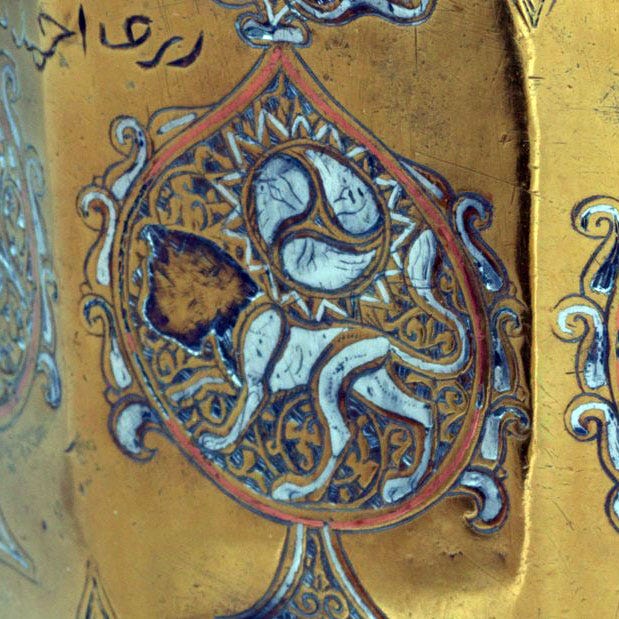
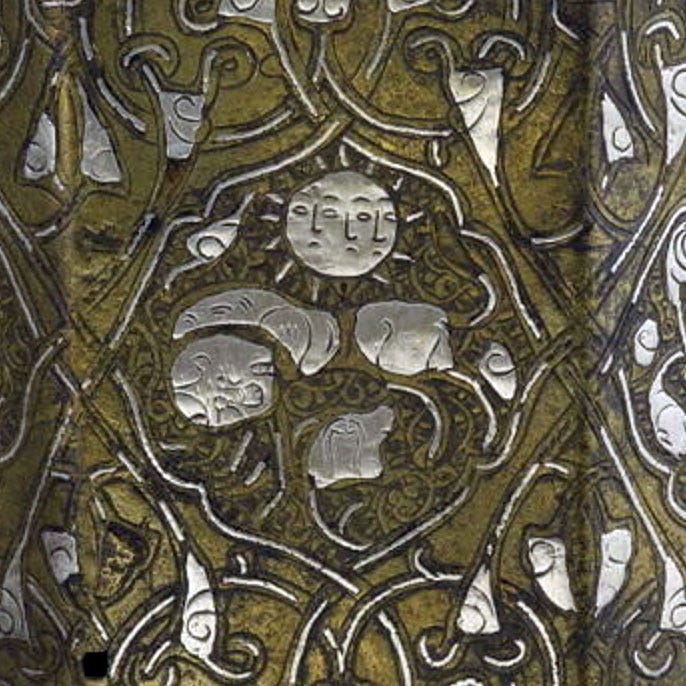
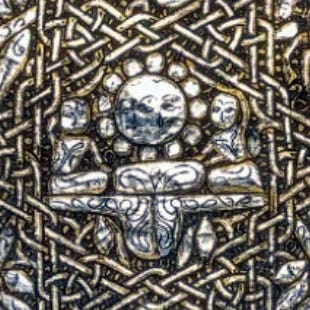

I haven’t been able to find any attempt at explaining this remarkable detail, despite the way it stares us in the face (sorry). But as the iconography of this system is Syro-Mesopotamian in nature, I can’t help but bear in mind the trinities described in my introduction: the Sun was always worshipped as one of three. Can this triple face be a conventional vestige of an ancient (and most definitely forgotten by then) tradition? I can’t be sure of the link, but I could find nothing else in local or more Eastern mythologies that could explain it.1
Of course some objects just display a plain sun disc, sometimes with a face.







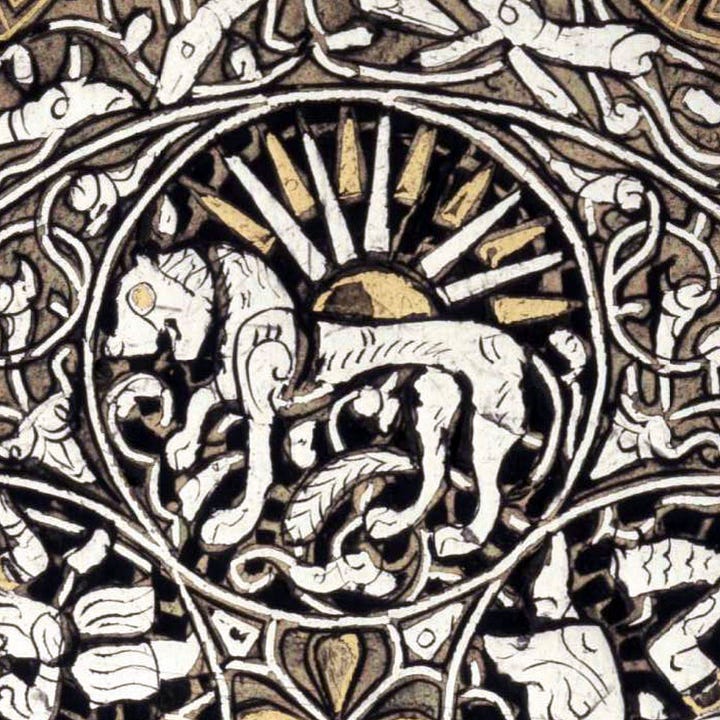
The way the Sun appears to rise from the lion’s back, in the pen box above and Manuscript 1 below, is significant but will be discussed in the article on Leo.
The Sun itself is a lavish interpretation of the Sundisc-as-face, but a simple gold disc when done on a smaller scale (seen here next to the Moon with a blue disc).





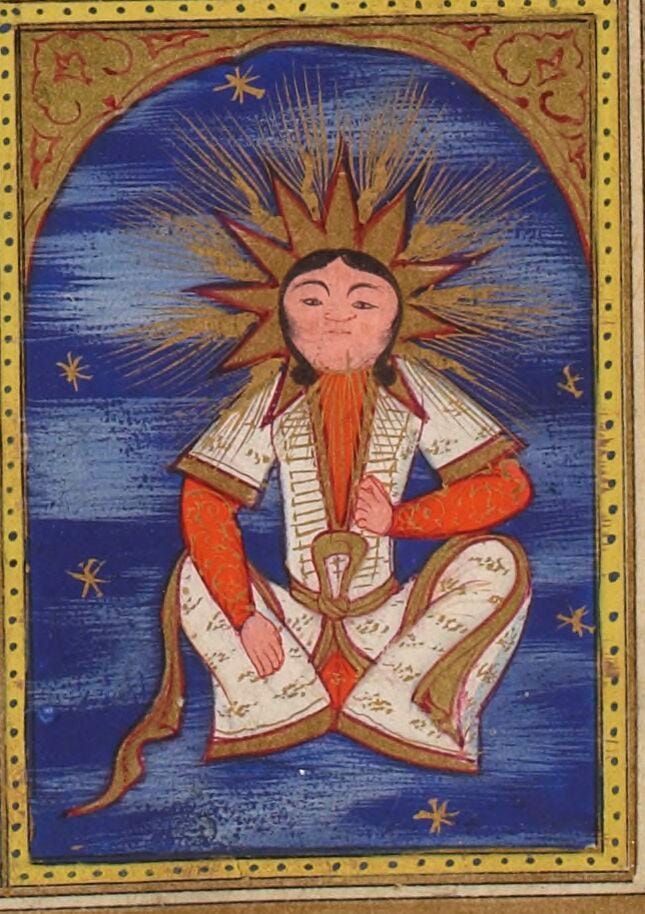
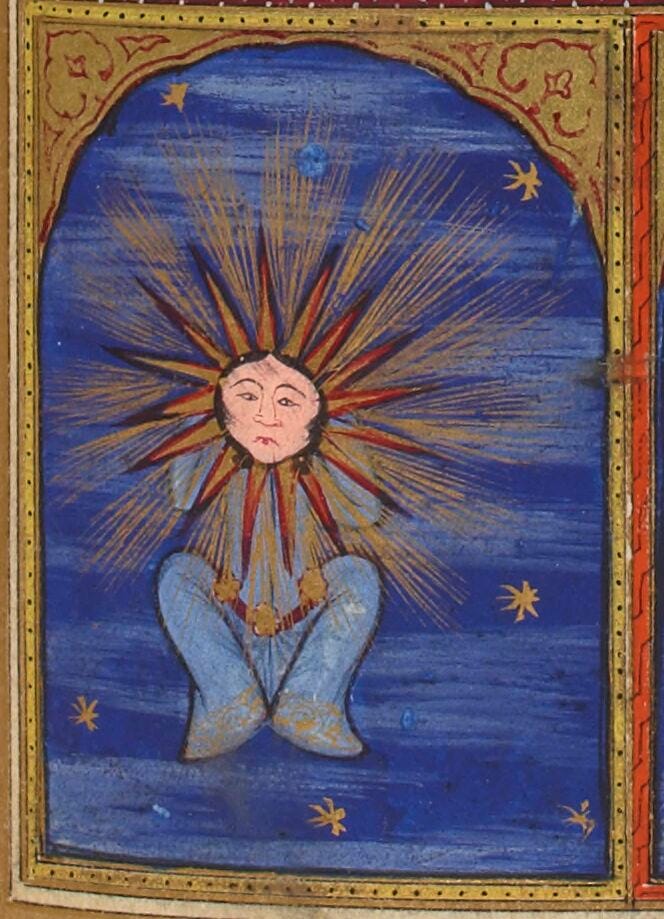
Sigil رسم
The symbol we see on the astrolabe is no mystery at all: it’s the Graeco-byzantine sigil that was also used to signify gold. It’s described as a “disc with a single ray”, though Gettings2 has a different take on it and states it is “presumably a derivative from the short-form helios”. There unfortunately no further elucidation, but if this is the case then it may validate my theory that other planetray sigils on this same astrolabe could be derived from their names. Again, the modern sigil ☉ was only created during the Renaissance, in the context of Christian esotericism (cf part 2 footnote 6).
The Ghāyat al-Hakīm version of the symbol is basically the same, only drawn less sharp. If that tapering cone was meant to represent a single ray, the Ghaya scribe was not aware of it.
To finish, here are some of the correspondences for the Sun listed in the Ghaya:
Languages: Frankish الافرنجية (Western European) and also shares Greek اليونانية with Mercury.
Cloth: Shawls and thin fabrics
Taste: Fatty sweetness الحلاوة الدسمة
Places: Strong foundations, places of rulers, important luminous places
Gemstones: Rubies الياقوت الاحمر , golden marcasite المرقشيتا الذهبية, hematite الشاذنج and every superior-looking sparkling red stone حجر احمر برّاق رفيع جليل
Minerals/metals: Pure gold الذهب الابريز
Plants: What is tall and fine such as the datepalm النخل and grapevines الاعناب; saffron الزعفران, daffodils النرجس, roses الورد; and shares wheat القمح, kermes3 القرمز and olives الزيتون with Saturn.
Pharmaceutics: Agarwood (oud) العود, sandalwood الصندل, cassia bark السليخة, shellac اللك and everything that has spiciness, and heat in its humors; of perfumes good agarwood (oud) العود الجيّد
Animals: Those that have bravery and strength and intense might, such as humans الانس, and the beautiful/lively among camels الفاره من الابل, and noble racehorses الجواد الكريم, and mountain rams الكباش الجبلية; and every bird adopted by kings such as ? السودانقات and vultures العقبان , and great snakes, and peacocks الطواويس, and also lambs الضأن and cows البقر, and it shares tigers النمر with Mars.
Colours: Moderate red الحمرة المعتدلة and golden yellow الصفرة الذهبية
Next stop: Mars!
Previous posts in this series:
If anyone knows anything about this I’d love to hear it!
Gettings, Fred. Dictionary of Occult, Hermetic and Alchemical Sigils. Routledge & Kegan Paul, 1981.
Kermes is of course a scale insect that feeds on oak sap and provides a red dye. It’s fascinating to see it lumped with the plants, like a growth.









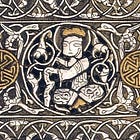

Enjoying your series very much. Perhaps Basin 2 is not an outlier. I see a third face as the circle itself with closed eyes at the top and an open eye central as the mouth. Just wondering.
Saved for later reading!